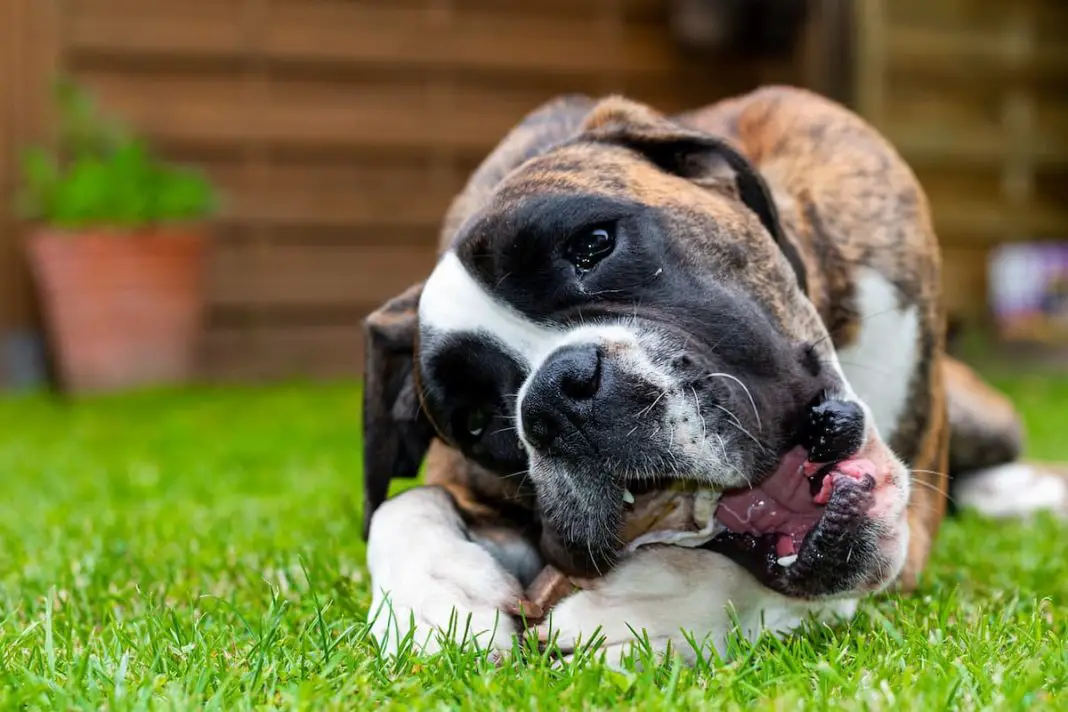Contents:
- What Is A Resource Guarder?
- Resource Guarding Begins From A Young Age
- Signs Your Dog Is Possessive Over Their Bully Stick
- Reducing Your Dog’s Obsessive Behavior
All-natural and single-ingredient bully sticks are a popular choice for satisfying a dog’s natural chewing instincts from their teething days to adulthood. Besides using bully sticks for redirected destructive behavior, bully sticks have the added benefit of preventing tartar build-up without exposing a dog to any potentially harmful additives.
Bully sticks are extremely high-value items for most dogs, even more so if it’s their first time with one. When giving your dog a bully stick, you should always leave your dog alone with it. No petting or teasing. Forcing a dog to give up such a high-value item will only make your dog more aggressive and protective of the bully stick in the future! However, if you want to try to get your dog to give up the bully stick for safety reasons, then we’ll give you an example of what you need to do.
What Is A Resource Guarder?
A resource guarding dog is a dog who values a specific item a lot and will feel threatened by any person or animal that comes too close to the item they perceive to have a high value. Resource guarding is quite a popular tendency in the world of animals, as it’s often linked to survival. The behavior of resource guarding can be the result of nurture or nature or a combination of both. Some dogs may be genetically predisposed to resource guard more than others; however, the environment could also be a big contributor.
Resource Guarding Begins From A Young Age
Resource guarding will usually start as early as in the litter, especially if there are many pups in the litter, and at times, the pups may start fighting over nipples. Another factor of resource guarding will come from the mothers’ genes, which may explain why some pups will resource guard more than others.
In another example, a breeder who feeds 10 puppies using only one feeding bowl could further exacerbate resource guarding in the pups simply because of the problem of overcrowding. A good and reputable breeder should be careful enough to provide sufficient food bowls, preventing overcrowding and episodes of resource guarding.
Resource guarding is a behavior that is learned and will progress over time; if the dog growled to protect a valuable in the past and has successfully worked to keep others away from their prized item, then a behavior pattern will establish because the behavior is ultimately reinforced.
Signs Your Dog Is Possessive Over Their Bully Stick
While the most distinctive signs of a dog that’s possessive over their bully stick is growling/showing teeth/biting, there can also be more subtle signs such as tensing up, freezing, staring, keeping the head low over the bully stick, or simply running towards their treat as soon as you are walking to the bully stick to lift it.
Typically, the closer you get to the dog with the bully stick, the more intense your dog’s reaction. Therefore, your dog couldn’t care less if you’re across the room but may suddenly react the moment you get closer.
Reducing Your Dog’s Obsessive Behavior
For this exercise, you will need to use high-value treats, not the average dog treats, that perhaps your dog isn’t as keen on. For example, if your dog’s favourite treat is something other than a bully stick then use that, in order for this to work, the treats must be of higher value than the bully stick. For example, some treats that your dog may prefer more could be freeze-dried liver, slivers of hot dog, chunks of roasted chicken or steak.
For the next step, you’ll be trying to find your dog’s threshold level. So, when your dog is guarding the bully stick, walk towards them from a safe distance (you can tether your dog for safety) and mark on the floor the distance, then they start freezing or tensing up. You don’t want it to get to a point where there is growling. Next, try placing yourself several inches BEFORE this marked zone from which your dog should feel more at ease. Remember that you’re working under the threshold, getting them systemically desensitized to your presence.
Walk back and forth a couple of times before coming to the mark, not towards your dog, but parallel to them so to ensure you get this distance right. Your dog should appear to be OK with this distance. If at any time you notice them stiffening, then it’s best to err on the side of caution and therefore make the distance greater.
From this distance, walk parallel and start tossing treats towards the dog every time you pass by them. If your dog resource guards the bully stick, find something of higher value to toss. Try doing this four or five times repeatedly during the day.
The next day, work again from the same distance; if your dog seems OK with it, then mark a closer distance just a few inches closer. Do the same exercise, walk parallel, as dogs see us less intimidating when we walk parallel rather than towards them and toss the treats as you pass by them. Repeat, repeat, repeat.
Continue with the exercise, decreasing the distance gradually day after day. If your dog growls at any time, freeze. Don’t leave; if you leave, you’ll only reinforce the growl (remember, the growling is a learned behavior, and therefore leaving reinforces the growl, in your dog’s mind, “Good, I’ve sent them away!”) The moment they stop growling, toss a treat.
At some point, you could be getting close to your dog. At this point, try giving a big reward for this. A jackpot of treats, i.e., a handful of tasty treats all at once, will make their day. Repeat, repeat, repeat. You should start seeing results at this time: you’ll get a little hint if their tail wags as you get close or anticipation (drooling, looking for the treat). This is good news and means that it’s worked! This is the power of counter-conditioning; your dog is now saying, “I no longer fear you are taking my bully stick away; I actually am starting to look forward to you coming near me!”
If you’re satisfied with the results, then keep up with the training by doing refresher sessions every so often, where you casually walk by and toss a tasty treat into their food bowl.
A great exercise for a dog that resource guards is teaching the drop it command. This exercise teaches dogs that when they give up their bully stick, that they’ll get something even better! This can also be a life-saving command for many different scenarios!
Remember to not reinforce guarding behavior by simply taking the bully stick away.
Caution: The above behavior modification test should be done with extreme caution and ideally should be done under the guidance of a dog behavior specialist.








